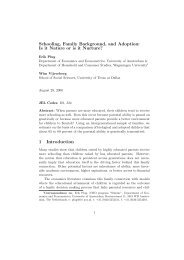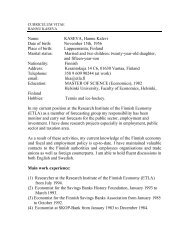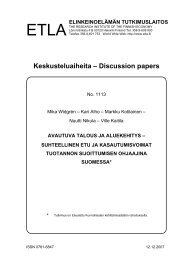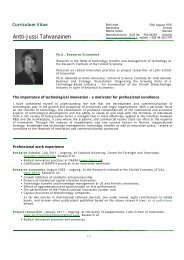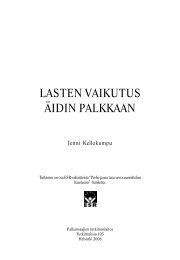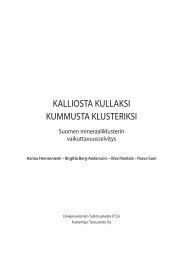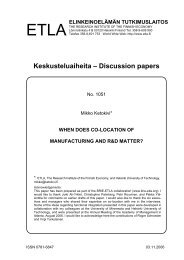Sergey Boltramovich, Grigory Dudarev, and Vladimir Gorelov ... - Etla
Sergey Boltramovich, Grigory Dudarev, and Vladimir Gorelov ... - Etla
Sergey Boltramovich, Grigory Dudarev, and Vladimir Gorelov ... - Etla
You also want an ePaper? Increase the reach of your titles
YUMPU automatically turns print PDFs into web optimized ePapers that Google loves.
5<br />
sale service systems. It creates a unique local system of industrial cooperation<br />
that exceeds <strong>and</strong> surpasses similar competitors’ systems by<br />
their possibilities <strong>and</strong> degree of development.<br />
• Company’s Structure, Strategy <strong>and</strong> Rivalry: The industry structure is an important<br />
determinant of the possibility to gaining competitive advantage<br />
if the industries are competitive <strong>and</strong> the competition motivates<br />
leading companies to invest in the product <strong>and</strong> market offering, management<br />
<strong>and</strong> marketing as well as process development. In this case<br />
the larger markets for essential supplies <strong>and</strong> components are created,<br />
infrastructure could be better targeted to meet specific requirements<br />
of the particular industries, the competitive pressures also motivate<br />
higher organizational efficiency <strong>and</strong> training as well as spin-offs.<br />
Porter offers for consideration two additional areas from which companies<br />
are able to draw sources of competitive advantage in his model:<br />
• Chance: The role of chance or “luck” reflects rapid changes on world<br />
financial markets; changes in currency quotations, an unexpected<br />
growth in local/international dem<strong>and</strong> <strong>and</strong> the event of war. All<br />
these sudden <strong>and</strong> unexpected events create situations on the market<br />
when unforeseen opportunities are created. In some cases these opportunities<br />
could become a source of competitive advantage.<br />
• Government: The influence of government, through its current policy<br />
(liberal, deterrent, etc.), is only considered as an attribute in analysis.<br />
However, this policy determines the performance of all actors in the<br />
regional <strong>and</strong>/or national economy. A rational governmental policy<br />
provides for the growth of potential investor confidence <strong>and</strong> attracts<br />
capital, experience <strong>and</strong> technology to the economy.<br />
As a result of studies of globalization, another potential source of<br />
competitive advantage was later added to Porter’s “Diamond” model of<br />
national competitiveness: this is international business activity.<br />
International business activity became a source of competitive advantage<br />
for companies from particular regions as a result of their internationalization,<br />
i.e. their ability to locate production facilities in regions that could<br />
offer the best advantages for the particular activity, <strong>and</strong> thus gain from<br />
access to several “diamonds” of the national advantage simultaneously.<br />
2.2 Concept of the Cluster<br />
As we discussed earlier in this Chapter the regional competitiveness is based<br />
on the ability of the particular location to offer the firms opportunities to<br />
gain competitive advantage owing to the specific factor <strong>and</strong> dem<strong>and</strong> condi-



